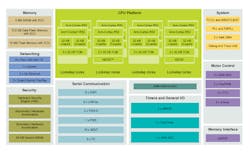New Microcontroller Lets Cars Call the Shots Once Humans Hand Over the Wheel
Companies like Nvidia and Intel are battling to build processors that act like the brains of autonomous cars, making decisions based on their surroundings to enable advanced driver assistance systems like automatic braking or adaptive cruise control and eventually to safely navigate city streets as well as highways. NXP Semiconductors is trying to turn those thoughts into action.
On Monday, the Eindhoven, Netherlands-based company announced a new microcontroller to manage the systems that accelerate, steer and brake vehicles safely. The hardware, called S32S, can act on commands not only from a driver’s turn of the steering wheel and foot pressing on the brake pedal but also from a car’s central computer. It will compete with rival chips from the likes of Renesas and Infineon.
The announcement reflects the understated role the world’s largest maker of automotive chips is playing in the driverless car industry. NXP’s automotive division is an almost $4 billion business, but the company’s executives have acknowledged that it could struggle to compete with Nvidia and Intel's Mobileye unit in the kinds of machine learning chips that enable path-planning for self-driving cars.
NXP has focused instead on boosting software reusability, which is arguably a bigger problem for Tier One suppliers than a lack of computing power. The company’s S32 platform is based on a common architecture – what NXP refers to as a “chassis” – so that software can be swapped out from higher end vehicles into lower end cars and scaled safely from advanced driver assistance systems to autonomous driving. The goal is to cut development time and cost.
The new microcontroller to be sampled in the fourth quarter is the first product based on the S32 platform since the company introduced its second-generation vision processor for front-facing and rear cameras in 2017. The chip is loaded with flash memory to support over-the-air updates with limited downtime. NXP plans to announce a vehicle networking processor by the end of the year.
“One of the things we’ve done is this ability of the architecture to be able to absorb multiple functions running on the same microcontroller,” said Ray Cornyn, NXP’s vice president of vehicle dynamics and safety. The new chip supports hypervisors, allowing real-time operating systems from independent vendors to run inside separate cores simultaneously, controlling everything from braking to engine control systems.
“And that’s not really been possible before with the level of capability you get in standard microcontrollers,” said Cornyn. The chip is manufactured with 16-nanometer technology and contains eight cores capable of running at 800 megahertz. The hardware includes fail availability, which enables continued operation even after detecting and isolating a failure in certain cores, and which is critical for safely removing drivers from cars.
The performance boost plays into potential changes in the car’s electronics architecture. Higher end vehicles today are weighed down with miles of wires connecting more than a hundred electronic control units that control everything from windshield wipers to automatic braking systems. They are programmed with millions more lines of code than fighter jets. But many companies are considering bundling these control units together.
The microcontrollers inside them would be replaced by multicore processors that can handle all the same functions. That could improve the scalability of cars, with new functions introduced through software updates rather than installing new electronic control units. Another possibility is a hybrid architecture, in which intelligence is put inside sensors around the vehicle rather than consolidated in a handful of supercomputers.
These architectural changes are only one of the many challenges facing the automotive industry. “Not least of these is the ability to get silicon in hand fast enough and with enough performance headroom to ease the transitions to autonomous cars,” said Ian Riches of market research firm Strategy Analytics. “A car can be extremely intelligent, but if it can’t act safely on a decision, you don’t have a reliable autonomous system at all.”
To enhance reliability, NXP uses Arm’s new Cortex-R52 core, which meets the most stringent safety level for automotive electronics. The standard, ASIL-D, means that it’s protected against electrical faults that could undermine the code behind functions like collision avoidance and lane-change warnings as well as faulty signals resulting from constant overclocking, radiation, vibration and other sources of wear inside cars.
Fault tolerance is critically important for autonomous driving in which the driver can take their hands off the steering wheel. NXP's new microcontroller could help customers more safely integrate artificial intelligence hardware from companies like Intel, Nvidia and Qualcomm. NXP’s chip is capable of playing a supervisory role since these processors are not typically considered ASIL-D systems by themselves.
“They don't have all the system checking and diagnostics,” said Cornyn. “What you’ll actually do is take one of these microcontrollers and plug it into the central computer to monitor that it’s making sensible decisions. It wouldn’t actually make decisions. It would just make sure that the other processor is following the right flow of code and that it’s not locked itself up someplace.”
In addition to driverless car uses, NXP’s chips could be deployed inside electric vehicles to boost energy efficiency through battery management and adaptive suspension. Once the vehicle completes planning its path, it can best determine how to save the most battery power. For example, the vehicle could expend energy climbing a hill so that it can recharge its battery from the wheels spinning on the downslope, said Cornyn.
About the Author
James Morra
Senior Editor
James Morra is the senior editor for Electronic Design, covering the semiconductor industry and new technology trends, with a focus on power electronics and power management. He also reports on the business behind electrical engineering, including the electronics supply chain. He joined Electronic Design in 2015 and is based in Chicago, Illinois.


